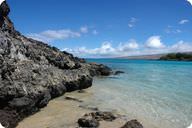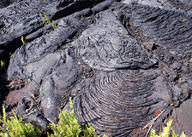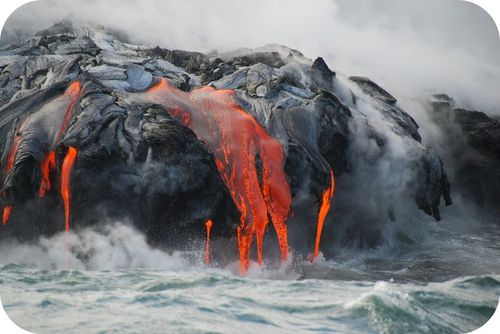7.4岩浆成分
章节大纲
-
Are all volcanic eruptions alike?
::所有火山爆发都一样吗?The type of eruption a volcano has depends on the type of magma in its chamber. Some eruptions are explosive. Some eruptions are quiet. All eruptions are amazing!
::火山爆发的类型取决于火山室中的岩浆类型。 有些火山爆发是爆炸性的。 有些火山爆发是安静的。 所有火山爆发都是惊人的!Magma
::玛格玛Magma forms deep beneath the Earth’s surface. melts below the surface under tremendous pressure and high temperatures. Molten rock flows like taffy or hot wax. Most magmas are formed at temperatures between 600 o C and 1300 o C ( Figure ).
::岩浆在地球表面深处形成。 在巨大的压力和高温下,地表下熔化。 软岩流如塔菲或热蜡。 大多数岩浆是在600摄氏度至1300摄氏度的温度下形成的(图 ) 。Magma beneath a volcano erupts onto the volcano’s surface. This image is of a magma chamber underlying Yellowstone.
::火山下面的岩浆喷射到火山表面。这个图像是黄石公园下面的岩浆室。Magma collects in magma chambers beneath Earth’s surface. Magma chambers are located where the heat and pressure are great enough to melt rock. These locations are at divergent or convergent plate boundaries or at hotpots.
::岩浆聚集在地表下的岩浆室中。 岩浆室位于热和压力足以融化岩石的地方。 这些地点位于不同或聚集的板块边界或热锅上。The chemistry of a magma determines the type of igneous rock it forms. The chemistry also determines how the magma moves. The higher the amount of silica in the magma, the higher the viscosity . Viscosity is a liquid's resistance to flow. Viscous magmas tend to stay below the surface or erupt explosively. These are felsic magmas, which are high in silica. When magma is fluid and runny, it is not viscous. This magma often reaches the surface by flowing out in rivers of lava . These are low-silica mafic magmas.
::岩浆的化学作用决定了岩浆形成的有色岩石的类型。 化学作用也决定了岩浆是如何移动的。 岩浆中的硅含量越高, 粘度越高。 可见度是液体对流动的抵抗力。 粘积岩浆一般会停留在表面之下或爆炸性地喷发。 这些是纤维岩浆, 它在硅中非常高。 当岩浆是流体和流体时, 它不是粘性。 这种岩浆通常通过流出岩浆的河流流入地表。 这些是低硅岩浆。Lava
::地 地 地 地The way lava flows depends on what it is made of. Thick lava doesn’t flow easily. It may block the vent of a volcano. If the lava traps a lot of gas, the pressure builds up. After the pressure becomes greater and greater, the volcano finally explodes. Ash and pyroclasts shoot up into the air. Pumice, with small holes in solid rock, shows where gas bubbles were when the rock was still molten.
::熔岩流动的方式取决于熔岩的构成方式。 熔岩不易流动。 厚厚的熔岩不易流动。 它可能会阻塞火山喷口。 如果熔岩捕获大量气体,压力就会增加。 在压力越来越大、越来越大之后,火山最终会爆炸。 灰和火化岩向空气中喷射。 石冰,加上固体岩石中的小洞,显示了岩石仍在熔化时的气泡。Fluid lava flows down mountainsides. The rock that the flow becomes depends on which type of lava it is and where it cools. The three types of flows are a’a, pahoehoe, and pillow lava.
::流体熔岩流向山坡。 流体熔岩流演变的岩石取决于是哪种熔岩,冷却在哪里。 三种流体是火山、和枕头熔岩。- A’a lava is the thickest of the non-explosive lavas. A'a forms a thick and brittle crust , which is torn into rough, rubbly pieces. The solidified surface is angular, jagged, and sharp ( Figure ). A'a can spread over large areas as the lava continues to flow underneath.
::熔岩是非爆炸性熔岩中最稠密的熔岩。 熔岩形成厚厚而薄的地壳,被撕成粗糙、粗糙的碎块。 凝固的表面是角状的、划合的和尖锐的(图 ) 。 当熔岩继续在地下流动时,岩浆可以散布在大片地区。
A'a flows can also be found in Hawaii and are much sharper and more jagged than pahoehoe.
::A'a流也在夏威夷发现 并且比pahoehoe更锋利 更尖锐- Pāhoehoe lava is thinner than a'a, and flows more readily. Its surface looks more wrinkly and smooth. Pāhoehoe lava flows in a series of lobes that form strange, twisted shapes and natural rock sculptures ( Figure ). Pāhoehoe lava can form lava tubes. The outer layer of the lava flow cools and solidifies. The inner part of the flow remains fluid. The fluid lava flows through and leaves behind a tube.
::Phuehoe熔岩比a'a更稀薄,更容易流动。其表面看起来更加皱纹和光滑。Pāhoehoe熔岩在一系列叶子中流动,形成怪异、扭曲的形状和天然岩石雕塑(Figure ) 。Pāhoehoe熔岩可以形成熔岩管。熔岩的外层冷却和凝固。流程的内部部分是液态。液体熔岩流出和流出一个管子。
Ropy pahoehoe flows are common on Kilauea Volcano in Hawaii.
::在夏威夷的Kilauea 火山中,经常出现phoehoe流。- Pillow lava is created from lava that enters the water . The volcanic vent may be underwater. The lava may flow over land and enter the water ( Figure ). Once in the water, the lava cools very quickly. The lava forms round rocks that resemble pillows. Pillow lava is particularly common along mid-ocean ridges.
::熔岩从进入水中的熔岩中产生,火山喷口可能在水下,火山喷口可能在陆地上流动,进入水中(图)。一旦进入水中,熔岩就会迅速冷却。熔岩形成与枕头相似的圆状岩块。在洋中脊,矿岩熔岩特别常见。
Lava erupting in the water can form bulbous, pillowy forms.
::在水中喷发的岩浆可以形成多泡、有枕头的形态。Summary
::摘要- Magmas differ in composition, which affects viscosity. Magma composition has a large effect on how a volcano erupts.
::岩浆成分对火山爆发的方式有很大影响。
- Felsic lavas are more viscous and erupt explosively or do not erupt. Mafic lavas are less viscous and erupt effusively.
::热熔岩的粘度更高,爆炸性喷发或不会爆发。 热熔岩的粘度较低,效果也更强。 热熔岩的粘度也更低,喷发效果也更强。
- Different lava types create different rock types, such as pahoehoe and a'a. Lavas that cool underwater become pillow lavas.
::不同的熔岩类型产生不同的岩石类型,如pahoehoe和a'a。冷却的水下岩浆变成了枕头岩浆。
Review
::回顾- What is the role of a magma chamber in a volcanic eruption?
::在火山爆发中岩浆室的作用是什么?
- How is magma composition related to viscosity?
::岩浆的成分与粘度有什么关系?
- Compare and contrast a'a, pahoehoe, and pillow lavas.
::比较和对比 a'a, pahoehoe,和枕头熔岩。
- A’a lava is the thickest of the non-explosive lavas. A'a forms a thick and brittle crust , which is torn into rough, rubbly pieces. The solidified surface is angular, jagged, and sharp ( Figure ). A'a can spread over large areas as the lava continues to flow underneath.



